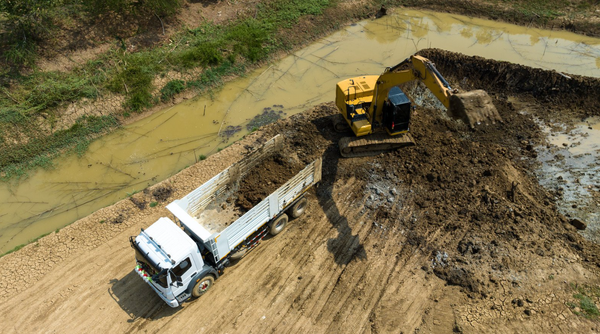Free Shipping Within USA | 1-year Warranty | Self Pick Up
How to dig a trench for drainage with a mini excavator?
Home improvement and landscaping projects can significantly enhance our living spaces and overall quality of life. However, efficient water draining is one aspect of landscaping and home improvement that is often overlooked or ignored completely. A good drainage system stops water from pooling, thus keeping your home and garden safe from water- related damage. Where it used to take hours to dig a hole for drainage, modern technology has provided us with a quicker way to dig the holes we need for our drainage systems. The mini excavator is a strong machine that can make digging trenches faster, safer, and more effective. This guide will show you how to dig a trench for drainage with a mini excavator. We hope that this can help you make a hard job much easier to handle.

Important Stops for Safety and Inspection Befere You Dig
It’s important to put safety first before you start digging a trench. This section talks about important things that need to be done to make sure the excavation is safe and your work goes smoothly.
01. Got in touch with your local utilities
To make sure that the working spot is safe, you should find and mark all underground utilities before you start digging. Hitting an underground utility line by accident can be dangerous and cost a lot to fix and fine for. To avoid these risks, call your local utility companies and ask them to mark where any underground systems are.
02. Chook Your Equipment
For safe and effective use, the mini excavator needs to be carefully checked over. Check the fluid levels (oil, coolant, and hydraulic fluids) and look for wear or leaks in the hydraulic hoses and lines. Also, make sure that all the control linkages work quickly and correctly, and that all the safety lights and operational indicators are working.
03. Safety Equipment for lodviduals
When you use a mini excavator, you need to wear the right safety equipment to protect yourself from common risks. At the very least, steel-toed boots, sturdy gloves, eye and ear protection are needed. It is also important to wear a hard hat and a high-visibility vest.
Getting the Site Ready
To keep your mini excavator from tipping over, make sure it is set up on stable and flat ground. Do not place the excavator near slopes or embankments that could shift or fall. Also, clear the work area of anything that could get in the way of the excavator’s movement or vision. These steps will help make sure that the digging process goes smoothly.

How to Dig a Trench for Drainage with a Mini Excavater?
01. Putting the Mini Excavater in Place
Putting your mini excavator in the right place is the first thing that needs to be done. To start, you can make the location of the hole clear by using neon paint or stakes with string to outline the exact path. To make sure the digger is stable and accurate, line up its tracks directly with this marked path. Setting up in this way helps make the digging process go smoothly and quickly.
02. Setting up the Bucket and Blade
Adjusting the blade and bucket on the excavator is necessary to get the trench to the right level. First, carefully remove the top layer of sod. Next, move the blade just below the depth you want as the soil needs time to settle. The slope of the bucket is important. Set it for effective penetration without excessive bouncing. For soils that are hard or rocky, you may need a steeper angle, while for soils that are looser, you may need a less active angle.
03. The Bigging Process
Begin the excavation by digging down to the full depth in one section before moving laterally to grade the sidewalls or expand the width. Repeat this process until the lowest grade is achieved across the entire planned line. For flat sidewalls and bases, the bottom edge of the bucket should stay vertical. Frequently use the bucket to get rid of rocks, loose dirt, or other things that fall into the hole. This will keep the walls clean and stable. By following these steps, you can dig a drainage trench that works well and accurately,
04. Utilizing Attachments
To make your small excavator more useful, you can use attachments that are made for specific jobs. For instance, augers can be used to drill, and hammers and grapples can help break up harder objects or get rid of trash. To get better results and speed, choose the right attachment for your job.

Are you searching for a high-quality mini excavator to dig a trench for drainage now? Look
no further than AHM 13.5HP mini elavatori This mini excavator has a powerful Briggs &
Stratton engine, whose lifespan is longer than the standard engines of Briggs & Stratton’s CR Series. It is designed for durability with a forged crankshaft and Dura-Bore™ cast iron sleeve. Furthermore, equipped with versatile attachments like a grapple, a bucket, an auger head, a hammer, a rake, and a quick hitch, this compact excavator is ideal for many works in tight spaces. Make your excavation projects easier and more efficient with this robust and reliable mini excavator now!
Digging a trench for drainage with a mini excavator is a powerful way to enhance your property’s drainage system efficiently. This guide has provided you with the necessary steps and tips to perform this task effectively and safely. Remember, proper planning, safety precautions, and correct operating techniques are crucial to the success of your trenching project. Whether for a residential landscape or a larger commercial property, a mini excavator can significantly simplify the process of digging a trench for drainage
